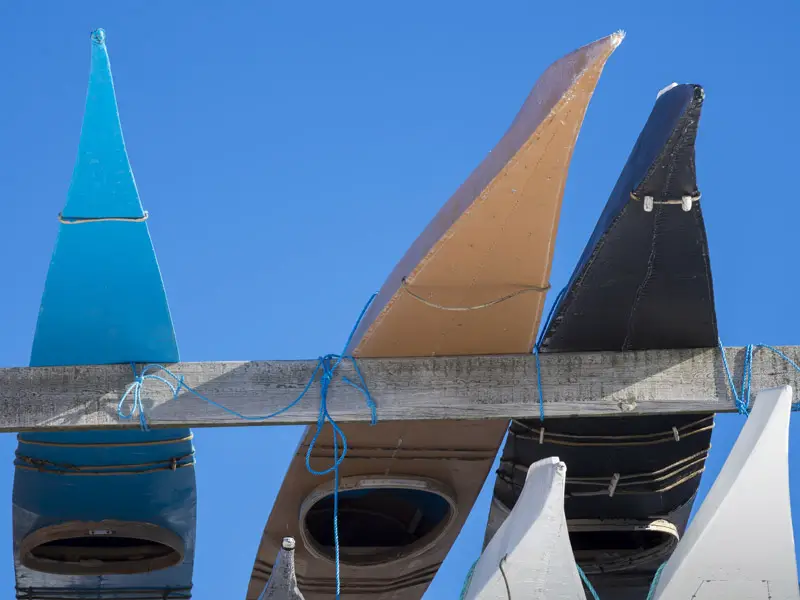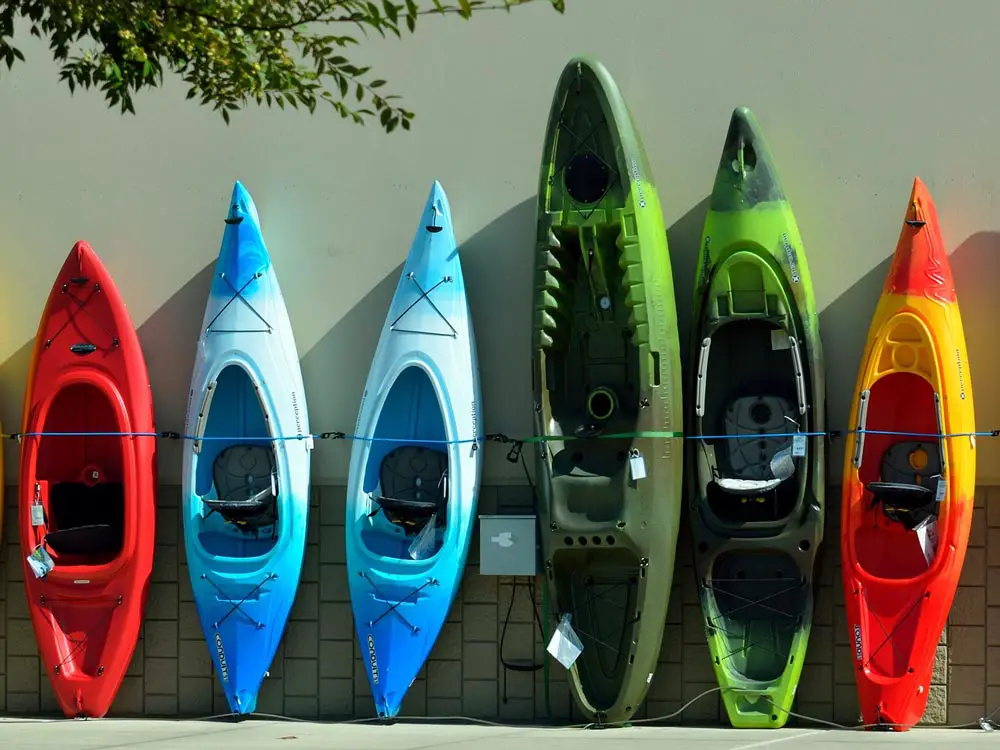Although nowadays kayaks are very popular as a means of sport and entertainment, in the past, they were a means of survival, being one of the oldest known boats, but when was kayaking invented exactly?
In fact, the first ancestors of this type of vessel found in archaeological excavations are at least 4000 years old. Driftwood molded with bone and animal skins to form a hollow interior. However, there is a general consensus that it was the Inuit ancestors who designed the kayak as we know it today.
When Did Kayaking Start?
When the first humans reached Alaska by crossing the then land bridge spanning the Bering Strait from Siberia, they needed to have some kind of craft to survive along the coatal areas they inhabited. This begins to give us an idea of the kayak’s origins.
In fact, the evidence indicates that these first peoples already possessed boats made from skin that they called “qajaq.”
Most experts in this field say that the word kayak means “clothing for walking in the water.” This is because they were built according to the hunter’s measurements.
On the other hand, another group of experts say that kayak actually means “man’s boat.”
The truth is that the Inuit themselves affirm that the kayak must be put on, not got into it. In fact, they created specific clothing to be used together with kayaks, such as the Anorak, made of animal skins that allowed them to have a greater seal for the cold waters of the Arctic.
But, Where Did Kayaking Originate?
In reality, this isn’t known in exact detail. Still, much evidence indicates that the kayak originated with the first peoples of Inuit, Yup’ik, and Aleut origin, who were the first to use this boat with the design we know today. They traditionally inhabited the northern circumpolar region, including Alaska, Northern Canada, Greenland, and parts of Siberia.
These boats for one or two people have always been a very suitable medium for harpoon hunting, which made them ideal for the conditions in the polar regions. Originally, the kayak cover was made of seal or walrus skin due to its availability in the environment and its high degree of impermeability. This skin was mounted on a frame made of driftwood or even whale bones.
Obviously, there were many geographical variations of the kayak, varying between different Inuit groups — formerly, there were more than 21 tribes. Each group made adaptations to these boats to meet their specific needs, based on the weather and terrain conditions.
- Baidarka style, the oldest design. from the seas around Alaska & Aleutian Islands, It has a more rounded shape and numerous chines that gives it an almost blimp-like appearance.
- West Greenland style kayaks are more angular in shape, have fewer chines, with gunwales rising to a point at the bow and stern.
- East Greenland kayaks are similar to the West Greenland are more maneuverable due to a steeper angle between the gunwale and stem, and are often more snugly fitted to the paddler.

In tribal societies like those, kayaks were much more than simple objects, since there was also a link with the boat. A good kayak could mean the difference between life and death.
Because the Inuit didn’t know – or perhaps didn’t want, to swim, these boats were made in such a way that the paddler was completely covered. In this way, in the event of a rollover, they could quickly return to their position through a maneuver called “roll.” Otherwise, they could quickly succumb to hypothermia in a matter of minutes. The “Eskimo roll” is still used as a critical skill in kayak safety even today.
The first remains of kayaks with the design that we know today are around 2000 years old. However, as I mentioned before, the remains of boats considered ancestors of the kayak are much older and have been found at least 4000 years old and possibly up to 8000 or 9,000 years.
As you can see, the origins of the kayak have made it a highly evolved boat over the centuries, and I think the word that best defines this boat is “adaptability.”
A Custom Made Boat
The Inuit are hunting and fishing people who have managed to survive in the harsh climate and terrain of the Arctic for millennia. Naturally, this adaptation has conditioned their cultural development. The kayak represents then, the best example of the hard work and intelligence of these peoples of Eskimo origin, and a fundamental element in their lifestyle.
This attitude reached the point where each hunter had to make his own kayak, and if for some reason when an Inuit went hunting and didn’t return, it was because he had used another hunter’s boat. In this way, the hunters needed to have their personalized kayak and become experts in its handling before starting a family, since their subsistence would depend on that.
Kayaking was a family affair. It’s known that women also participated in the development of kayaks, tanning the skins that would be used as cover on the boats, and even Inuit children were taught kayaking from an early age, and around the age of 12, they were able to hunt their first animals, which also meant they could get married.
From the 18th century, a white camouflage screen made of cotton known as “Taaloq” began to be used, mainly as camouflage to hunt seals. It’s believed that it was a man of Danish origin who introduced this adaptation.
When Was Kayaking Invented as We Know it Today?
Russians made their first contact with the native Inuit in the Aleutian Islands in 1740. As Russians hunted seals and sea otters for their fur, they quickly realized that the great hunting skills of Aleuts kayakers would be very useful to them.
Russians began to hire, coerce, and enslave the Inuit people into intensively hunting seals and otters. The result of this is that they almost wiped out the sea otter and made the Inuit lose their traditional way of life, leaving kayaking as a tradition for a minority group.
The Rob Roy Kayak
It was in 1845 when the Scotsman John MacGregor built his own version of the kayak based on old sketches of Inuit designs. MacGregor gave him the name “Rob Roy” and set out to tour Europe in his new boat.
Books of his adventures began to be written, which became very popular and helped turn kayaking into a medium for sport and exploration.
McGregor made his Rob Roy kayaks with strips of cedar and oak, measuring 15′ by 2’6″ (4.6m by 76cm) and weighing about 66lb (30kg). On some occasions, he even rigged it with a sail, or used them to navigate rapids. This first generation of modern kayakers gave birth to the world’s first kayaking club, the Royal Canoe Club, in 1873. The first kayaking race was held in London in 1867. So, in the response to “when was kayaking invented as we know today”, the closest answer we can give is 1867, in London.
Hans Klepper And His Revolutionary Design
In 1905, the German Hans Klepper bought a patent for a new kayak design and began mass production, albeit with some limitations.
It was a new concept of folding kayak that was based on a wooden cage covered with a rubber cover. This allowed the kayak to become accessible to many people, as well as showing the way to other potential manufacturers.
By 1936, kayaking was so popular that it became an Olympic sport, and Klepper’s designs won 18 medals. Klepper’s designs are still in use today after over 100 years of production.
Kayak Use In War
With the Second World War’s arrival, the kayak began to be used in some special operations. The most famous of all is perhaps the Frankton operation.
Six double kayaks were launched from a submarine off the Atlantic coast of France. Their objective was to reach Bordeaux crossing the Garonne to sabotage the port. Behind enemy lines, it was along an 80 km stretch of river in the heart of occupied France.
Only two kayaks made the journey to reach Bordeaux, where they set limpet mines and damaged several ships in port . There were four survivors, but only two made it to home.
After the war, the International Canoe Federation (ICF) was founded in Switzerland to bring together all the national federations, something that was very important to organize professional sports events, not only speed, but also slalom competitions.
The Appearance of New Materials
From 1960 the sea kayak began to become very popular as a recreational medium, due to the use of fiberglass, but it wasn’t until 1976 that the American brand Perception introduced the kayak made in molded plastic with their Quest model. This would mean a massification of kayaks due to their lower cost.
It was this idea that allowed the self-emptying kayak to appear. These were originally made to order in fiberglass, but the Ocean Kayak company bought the idea and launched the Scupper Classic in the early 1980s. Given time, plastic sit-on-top kayaks have appealed to a wider audience, bringing the sport to even more people.
Related: Sit inside or sit on top, what’s the difference?

The Kayak and the Adventurous Spirit
Kayaks have been used throughout modern history for some truly remarkable exploratory feats.
1.- Atlantic Ocean
In 1928, Franz Romer Kayaked 4,000 miles from Portugal to the island of St Thomas in the US Virgin Islands, in 58 days. He accomplished this with a modified Klepper aided by a sail. Although shipwrecked and drowned on his onward leg to New York, he was the first man to cross the Atlantic Ocean on a kayak.
2.- Germany to Australia
In 1932, Oskar Speck crossed the Danube River to the Mediterranean, but the interesting fact is that he then sailed for seven years to Australia. He achieved this using four Pionier folding kayaks. This trip has also since been made by other modern kayakers.
3.- Going Down the River Nile
Another epic trip was that of John Goddard with two of his friends, descending the Nile River from its sources in 1950. A journey that made for some stories at that time.
4.- Rounding Cape Horn
In 1977, kayak designer Frank Goodman accompanied by three friends became the first kayakers to round the infamous Cape Horn. In 1975 he had previously completed a 500-mile journey along the Norwegian coast to advertise his Nordkapp sea kayak.
5.- The Pacific Ocean has its turn
In 1987, the North American Ed Gillet manages to cross the Pacific Ocean using a kayak for the first time in history. He set out from California on June 25 and finished in Hawaii, for which he had to paddle 2,200 miles in 63 days on the open sea.
The History Of Kayaking Continues To Be Written
There are of course many more incredible journeys than we can mention in just one post, and more continue to be made every day. The kayak has evolved from a vital tool for survival into the recreational vessel that we know and love today.
You may also be interested in:
Who Invented The Canoe?
The History Of Paddle Boarding
